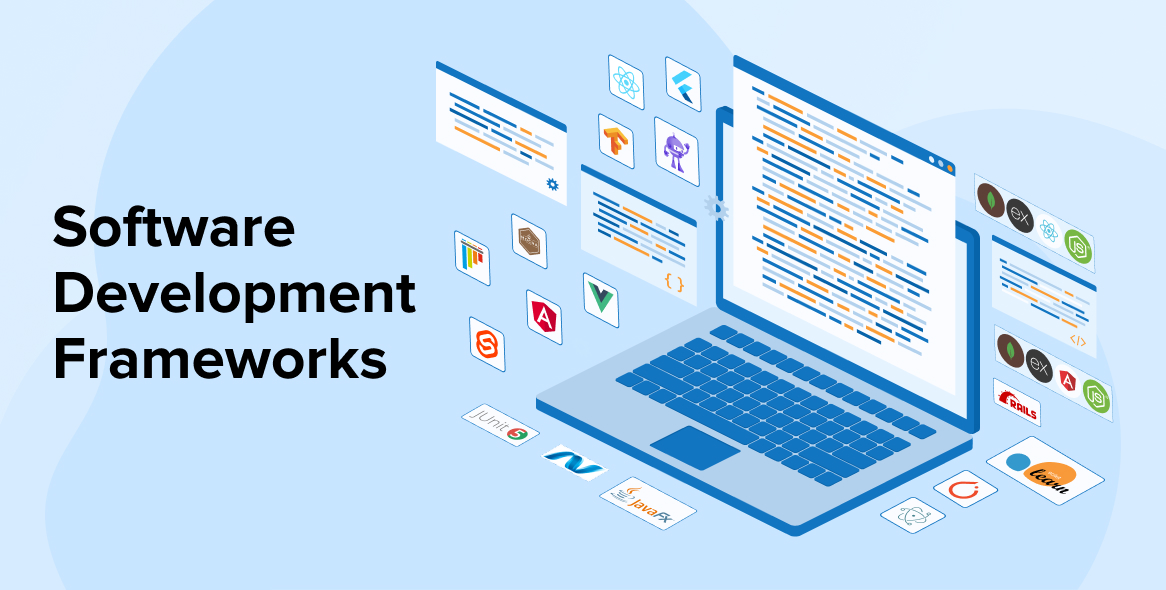
The surge of digital apps proves that we are progressing towards a more efficient and lightning-fast digital world. We have been seeing newer apps invading the market space and making a place within the minds of consumers. Among these trail-blazing applications, some of them are developed using Low-code platforms. Low code platforms are new to this arena of app development. There is a large difference when comparing low code vs traditional development methods and it can be a game changer if used aptly in the right direction.
In this blog post, we will look at basic details, pros, cons, and other important aspects of the low code platforms and traditional coding practices that a software development services provider uses to develop efficient solutions.
1. What is Low Code?
To start with, we will know how Low code differs from traditional coding. So, to define Low code, we can say, Low code is an application development method where you use minimal codes to develop an app/software, also without any prior knowledge of programming languages. Low code enables easier, faster, and more inclusive application development. When you use Low code development platforms, you’ll tend to understand how these platforms are faster and more efficient in the process of developing and delivering applications compared to traditional coding practices. Low code platforms also provide numerous benefits to businesses seeking efficient app development. To put it in simple words Low code platforms accelerate your custom software development process.
When you start to build an app on a low-code platform, you can see that the platform is very simple to use. Any layman is able to use and implement these applications. The low code platform offers a drag-and-drop interface to perform the coding. The functioning of both Low code and no-code development platforms are almost the same. You can use both to develop customized business apps.
Statistics are almost quite evitable that nearly 70% of organizations believe that low code is less expensive than traditional programming. Low-code can help your company save $50-$100,000 on application development costs and also speeds up app development. It only takes a few months instead of six.
1.1 When to Use Low Code?
Choosing Low code for your business majorly involves three basic scenarios that have pushed the need for low code within enterprises.
1.1.1 Low Code Works Well if You Want to Develop a Quick App Development
Today businesses are highly driven by innovation within a company, but they are held back by their inability to put these innovative ideas into action. When you use Traditional development, it necessitates hardcore coding abilities that are only possessed by IT professionals. As a result, your business users must rely on the IT department, where there is a list of development projects inline, to bring their ideas to life. But with the use of low code, you no longer have to rely on specialized IT experts.
Low code platforms allow a person with little to no coding experience in building apps that meet their requirements. Because of the simple user interface and simple design process, they can build applications with minimal reliance on the IT department.
1.1.2 If You Want Custom Development of Applications
Certain business problems are unique to a particular department or organization and necessitate customized solutions. In such cases, traditional development can be prohibitively expensive and not worth the investment. Most businesses, ideally, wouldn’t prefer to invest in technologies if the development time is more than expected, with delayed feedback loops, and a lack of skilled developers to do the entire task.
However, with low code, businesses can easily build and rebuild apps to meet their changing needs.
1.1.3 If You Want to Drive Agile Transformation within Enterprises
Traditional development may not be suitable for such a scenario because it is less adaptable to continuous changes. Furthermore, the speed-to-market for these internal transformations must be fast in order to maximize their effectiveness.
In such cases, low code can be an excellent choice for developing applications that foster agile transformations within a company. It enables changes to be made quickly, and if these changes do not work, they can be rolled back just as easily. This enables business users from various departments to freely modify apps in order to facilitate internal transformation.
Now that we have understood what is low code and when it should be used, it is now time for us to understand the conventional method of developing apps – Traditional Software development.
1.2 Pros of Low Code Platforms
Now that we have made a close comparison of both types of implementation methodology. It’s time for us to take a closer look at the advantages of the low-code platform that can sway businesses away from traditional development.
- Highly Agile: Traditional apps take a long time to develop and release to app stores. Because of built-in features, reusable templates, and automated testing, no-code and low-code development platforms help non-technical people and developers alike design and deploy apps faster, improving developer agility.
- Higher Cost Benefits: When you use Low/no-code development platforms, such platforms enable your business to deliver applications for immediate use at a lower cost than traditional software development. As a result, low-code development does not require a team: you could indeed look for other developers working as freelancers or do coding on your own if you have prior experience.
- Adaptive to Newer Business Conditions: Since the market and competitors are constantly changing, you must be able to respond quickly to rapidly changing business conditions. Low-code development platforms empower their businesses to perform updates with their apps on the fly and also stay competitive.
- Proven Test Features: Low-code and no-code platforms provide tried-and-true features. Templates can be seamlessly integrated with one another to work efficiently across multiple devices and platforms, ensuring a positive user experience. However, there is a limited number of templates.
- Easy to Maintain & Upgrade: When you use low code/ no-code development platforms you do not need specialist IT professionals to get things done. You can simply use the upgraded or modified version of the codes. Such codes are prebuilt, pre-configured, and tested modules so there is less effort in terms of time and cost.
1.3 Cons of Low Code Platforms
The Low code might look quite lucrative in every term but then you as a business must consider the following drawbacks before starting to use low-code development.
- Poor Personalization: The first con of this No-code/low-code platform is modular components. This ensures quick app development but then the customization will be limited. In order to meet custom business needs, we might need components that are able to meet custom business requirements. However, with a no-code or low-code platform, you will most likely adapt your business needs to the capabilities of your app.
- Restricted Integrations: If you rely too heavily on low-code development platforms, you will definitely have integration issues. Such platforms with low and no code app provide limited functionality and can still integrate with most internal systems and third-party services.
- Security Reasons: Non-technical platform users can create vulnerabilities that they are unaware of. Thus, some codes which are not secure will remain unidentified and thus the end result would suffer. Low code apps come with security aspects at stake and thus, you need to be highly proficient in low coding so that even if there is the slightest threat, the prevention plans should already be in place.
2. What is Traditional Software Development?
Traditional software is a classic way how the software development process works. It also helps in designing and developing simpler applications. It can be easily utilized when the software’s security and other aspects are not a considered priority. Most of your traditional ways of development use long lines of codes and need more time to develop desired apps. It is divided into five stages: Analysis of requirements, Designing, Implement stage, Testing and Coding, and Maintenance. Traditional software development is a linear structure where security is less focused. It is a fixed model and has a limited development cost.
These are the primary software development methodologies. Because these processes are somewhat complex and time-consuming, they are also known as heavyweight methodologies. Most of these methodologies are supported by a series of sequential steps such as requirement definition, solution development, testing, and deployment.
2.1 When to Use Traditional Development?
For businesses to stay relevant, it is imperative to understand the conventional modes of development. Traditional software development can be used for applications requiring a high level of specialized interactivity.
2.1.1 When Your Business Wants Higher Interactive Applications
You should always choose the traditional way of development if you decide to develop highly interactive web and mobile applications. Some applications necessitate a high level of specialized interactivity. Though low code platforms can generate highly efficient applications, they lack the flexibility and freedom that traditional development provides when developing apps. These traditional development platforms have the ability to provide an infinite number of functionalities.
2.1.2 Open-Ended Solutions
Some business problems necessitate open-ended solutions. Because these problems have an unstructured resolution process, developing an app without a predetermined structure can be difficult.
A low-code development platform works optimally for solutions whose structures are defined structures and thus they must be designed as per the needs. As a result, cases that are more open-ended and unstructured cannot be solved using low-code platforms.
2.2 Pros of Traditional Approach
Since we have seen some of the strengths and downsides of low code development platforms, it’s now time to see what pros of the Traditional development method.
- Higher Control: When you use a Traditional app development platform, you can excel with complete control over the coding side of App development. Professional developers have the most control over how their code and they single-handedly manage and write codes on how the applications should be structured.
- Flexible Functionalities: Companies could indeed tweak custom code in any way they want. They can practically add any feature and integration is possible. When creating a custom app, you can use whatever technology you want, and also add tooling, hosting, and APIs in the way, you want to achieve the desired functionality.
- Special Ownership: Another advantage of traditional development is total control over the creation of software. Companies that choose custom apps control the app’s architecture, security, and integrability, among other things, because they own the source code.
- Flexible Access: Unlike Low code, you don’t have to wait for any precode application, Traditional development can be accomplished with virtually any programming language and development platform. Using traditional custom development, you can develop all types of customized apps, using any programming language or code and it will still be highly scalable and agile.
- Deploy anywhere: Low code apps demand some specific platforms get their apps deployed. But it is not the same with Traditional Apps. All the apps created in the traditional manner can be deployed to whatever destinations developers choose to support.
2.2 Cons of Traditional Approach
Below are some cons of traditional software development approach as compare to low code.
- Higher Cost: When you start to develop apps with the traditional development process, it would require you to do serious budgeting. Depending on the scope of the project, you would need to add features again and again. This will consume most of the time and will also increase your budget. Then to save time and money, you might need the help of an expert. This includes involving experts as well as thinking to outsource.
- Unexpected Time: When you use manual traditional programming, it takes more time than auto-generated code/low-code tools. You already know that it also takes longer to manually tweak code to support multiple platforms and programming languages and build sockets and other interfaces between applications and services.
- Need for Specialized Skills: Traditional development may necessitate more specialized knowledge of a particular programming language or development platform. Still, low-code development necessitates specialized knowledge.
3. Low Code vs Traditional Software Development
If we think of differentiating low-code/no-code application development platforms from the traditional ones then we have a plethora of things to differentiate. Low code allows developers and business users to quickly create apps with the functionalities of drag-and-drop interfaces, and custom app development methodology. With traditional methods, you can create reliable and robust apps. Though custom application development is more inclined to work better with Traditional Software development and in low code you require more effort to develop a custom application. Here are some other key differences between the two approaches:
3.1 Agility
Traditional development platforms are less agile as some of their components have complex configuration systems. Furthermore, because the codes are so complex, learning and correctly operating them takes a long time.
Low-code platforms, on the other hand, are the simplest machines in the planet to use and operate and come with drag-and-drop functionality. Furthermore, unlike custom application development platforms, you do not need to write codes to develop the applications here; instead, you can simply use the drawing methods.
3.2 Cost
The design and development of traditional or custom-made software are unpredictable and expensive. Although the price will differ from the scope of the project and the needs of the company, sometimes the cost will still be quite high. This is typically a viable option for large corporations that require highly customized software that is difficult to create using a low-code solution.
Low-code/no-code platforms are significantly less expensive than their traditional counterparts. This happens as when you use low-code platforms, you are paying for a specified service, rather than the entire development process.
3.3 Resource Talent
While the time you use the traditional application development approach, it typically includes a number of tools and functions that aid developers in the creation of highly complex applications. If you wish you use traditional app development accurately then you would need highly technical and sophisticated skilled software developers from this field.
On the other hand, Low-code app development lacks a wide range of tools and functions. Typically these platforms include a small set of tools that can assist you in developing various types of applications and the lesser input. Also, the low code developers are sometimes non-technical staff who lack technical expertise.
3.4 App Reliability
As of their high technicalities and overcomplicated nature, custom application development platforms frequently produce a large number of bugs, making it difficult for users to use the apps.
Enterprise low-code/no-code platforms, on the other hand, rarely produce bugs while developing apps. This results in this system’s apps running smoothly and without hiccups.
3.5 Maintenance
Post-development maintenance is a major challenge as there are evolutionary updates with traditional coding. The updates or revisions require a dedicated in-house or third-party development team to implement changes.
Low-code platforms, on the other hand, are typically run and maintained by the company that owns the platform. This simplifies the maintenance process because all software updates and improvements are handled by the hosting company rather than the business that subscribes to the software.
4. Who Won the Battle Between Low Code and Traditional Development?
In this whole process of understanding how low code vs traditional development process, we had our share of insights about how both these development changes the whole look and feel of the developed application. Looking at enterprise application development from a company’s perspective, we can say that depending on what you choose, it will save a significant amount of time and money. Whilst also allows businesses to invest in many vital activities. both low code and traditional development are a worthy choice for businesses to accelerate their business game to the next level.






Comments
Leave a message...